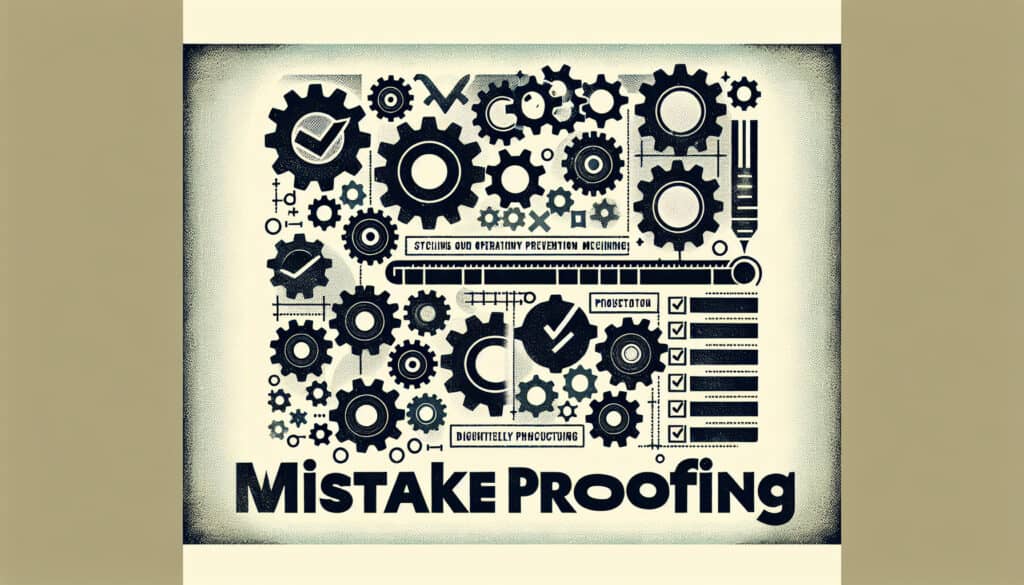To prevent errors from occurring in a process.
- Metodologie: Lean Sigma, Produzione, Qualità
A prova di errore (Poka-Yoke)

A prova di errore (Poka-Yoke)
- Miglioramento continuo, Progettazione per la produzione (DfM), Prevenzione degli errori, Produzione snella, Poka-yoke, Miglioramento dei processi, Garanzia di qualità, Controllo di qualità, Sei Sigma
Obiettivo:
Come si usa:
- A Japanese term that means 'mistake-proofing'. It is a technique for preventing errors by designing processes and products in a way that makes it impossible for errors to occur. For example, a USB plug can only be inserted in one direction.
Professionisti
- Prevents errors from occurring, which improves quality and safety; Can reduce costs and improve efficiency.
Contro
- Can be difficult to implement for all types of errors; May not be a substitute for training and supervision.
Categorie:
- Lean Sigma, Produzione, Qualità
Ideale per:
- Designing products and processes in a way that prevents errors from occurring, such as in a manufacturing assembly line.
Poka-Yoke techniques can be applied in various sectors such as automotive manufacturing, healthcare, electronics, and food processing, where minimizing errors is paramount. During the design phase, engineers and designers collaborate to identify potential failure points within a process or product, enabling the implementation of fail-safe mechanisms before production begins. For instance, in a manufacturing assembly line, fixtures can be designed to guide components into correct positions, while in software development, user interfaces can include prompts that prevent data entry errors. Quality control teams often integrate Poka-Yoke principles to enhance inspection processes by employing checklists or automated systems that flag inconsistencies. This methodology can be initiated by project managers or quality engineering teams, encouraging involvement from cross-functional teams including production workers who can provide insights on practical challenges faced on the shop floor. Industries such as healthcare utilize Poka-Yoke through medication dispensing systems that ensure patients receive the correct dosage, emphasizing patient safety and operational efficiency. The implementation of these techniques not only enhances quality but also leads to significant cost savings, as the expenses associated with rework, waste, and customer complaints diminish. By embedding error-prevention measures directly into processes, organizations cultivate a culture of continuous improvement, reinforcing accountability among employees while fostering operational reliability.
Fasi chiave di questa metodologia
- Identify potential failure modes in processes or products.
- Evaluate the impact and frequency of identified failure modes.
- Develop solutions that eliminate or reduce the likelihood of errors occurring.
- Implement Poka-Yoke devices or methods in the design process.
- Test the effectiveness of the implemented solutions under real conditions.
- Iterate on the design based on feedback and error occurrence rates.
- Educate users about the Poka-Yoke features in the design.
- Establish a monitoring system for ongoing error detection and prevention.
Suggerimenti per i professionisti
- Integrate error detection sensors in assembly lines to provide immediate feedback on incorrect part positioning or insertion to prevent defects.
- Design interchangeable components that can only fit in one way or are distinguishable by tactile cues, reducing the risk of assembly errors.
- Implement standardized work processes with visual aids and limits on part usage to curb mistakes during repetitive tasks on the manufacturing floor.
Leggere e confrontare diverse metodologie, raccomandiamo il
> Ampio archivio di metodologie <
insieme ad altre 400 metodologie.
I vostri commenti su questa metodologia o ulteriori informazioni sono benvenuti su sezione commenti qui sotto ↓ , così come tutte le idee o i link relativi all'ingegneria.
Contesto storico
1950
1950
1950
1960
1960
1960
1960
1950
1950
1950
1958
1960
1960
1960
1960
(se la data non è nota o non è rilevante, ad esempio "meccanica dei fluidi", viene fornita una stima approssimativa della sua notevole comparsa)















Post correlati
Meta-analisi
Mappatura dei messaggi
Diagrammi del modello mentale
Forze di spinta e di trazione massime accettabili
Pianificazione dei fabbisogni di materiale (MRP)
Programma di produzione principale (MPS)